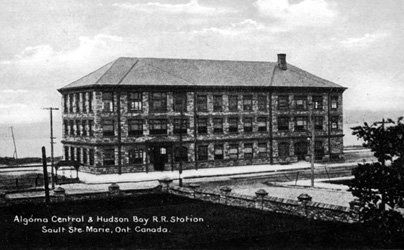In 1914, just over 100 years ago, passenger train service was completed from Sault Ste. Marie to Hearst for the very first time, after over twenty years of building. It became a staple mode of transportation for residents and tourists alike – who utilized the train for a plethora of reasons, including social visits to communities, cultural visits to First Nation traditional territories, to reach employment and education institutions, to access regional healthcare and trap-lines, and to view the spectacular landscapes of the boreal forest and scenery that inspired work done by the Group of Seven artists, as well as Indigenous artists for 1000s of years before them (BDO, 2014, p. 10-11).
In the early 1900s, regional tourism was being heavily promoted in the Algoma region, primarily as a result of the influx of European settlers. Fishing, hunting, and camping became daringly attractive, and train was the only way to gain passage to the remote locations where this was possible. This created a huge boom in the northern economy, and the development of many small communities along the rail corridor, many of which still exist today – and are just as remote and beautiful as they were 100 years ago. This boom continued well into the latter half of the century, especially with the tourist stopover at the Agawa Canyon, and the subsequent development of the Snow Train (Malone, Given, Parson LTD., 6). In addition to those successful tours, the Algoma Central Railway also marketed a ‘Tour of the Line,’ which was a round-trip from Sault Ste. Marie to Hearst, ‘Tracks to Trails,’ which was a snowmobile excursion experience, ‘Wilderness by Rail,’ which consisted of partnerships with adventure travel and tour operators, and accommodation in the “Camp Car” at the Agawa Canyon (Malone, Given, Parson LTD., p. 7).
While many people enjoyed the touristic elements of the train, for many remote communities north of Sault Ste. Marie, rail was the only means of getting in and out of town. This was the case in Wawa (until the Trans-Canada highway reached it in 1960), and residents relied entirely on rail service in order to access any regional needs (CAPT, 2013). Today, with no passenger rail service, these issues have again become concerning. Read more about that in our blog on accessibility, found here
Throughout the late 19th and early 20th centuries, the construction of the rail lines within the Algoma region attracted a huge population of European settlers, who took over the territory that First Nations people had lived on for centuries (CAPT, 2013). The Canadian government capitalized on the glory years of the railway by passing laws that allowed them to expropriate reserve land without consent or consultation of the First Nations peoples, with no compensation, in order to build infrastructure (CAPT, 2013). Not only did this create strife between European settlers and First Nations people, but it also split up many reserves.
The influence that the train had on First Nations people, primarily the Missanabie Cree, cannot be emphasized enough. Not only did they use the train to express and retain elements of their culture – such as to access trap lines and traditional hunting grounds – but there is a much darker side to the intricacies of the Algoma Passenger Train to the Missanabie Cree. Shirley Horn, member of the Missanabie Cree First Nation, recalls that as a child, she and many others would take the train from their home in Missanabie to the Shingwauk Residential School in Sault Ste. Marie (Doxtater, 2016). While this is a painful element of Canadian and First Nations’ history, it is an aspect of our collective history and past that we need to acknowledge through reconciliation (Doxtater, 2016). This, in some small way, can be achieved through government funding of Ontario’s 1st First Nation Train – Mask-wa Oo-Ta-Ban – so that the Missanabie Cree can self-govern this mode of passenger rail on their traditional territory, in a way they had never been privy to since the rail corridor land was stolen from them.
References
BDO Canda LLP. (August, 2014). Algoma Central Railway Passenger Rail Service: Economic Impact Statement. Sault Ste. Marie, On. 12-13.
Coalition for Algoma Passenger Trains (CAPT) and Paat, B. Ed. (2013). 100th Anniversary Guidebook. All Aboard Algoma: Over 100 Years of Passenger Service, Sault Ste. Marie Museum Exhibit.
Doxtater, L. (January 2016). First Nations Relationship to Development of Rail: A Literature Review. Retrieved from the NORDIK Institute.
Malone, Given, Parsons LTD. (September, 2007). Algoma Central Railway: Wilderness Tourism by Rail Opportunity Study. 6-7.
Would you like to see the Mask-wa Oo-ta-ban, or "Bear Train," operating again between Sault Ste. Marie and Hearst?
Take the Bear Train Survey & Let Us Know


Stay Up to Date
Join our email list.
Join Newsletter
Thank you for signing up for our email list!
Please try again later.


